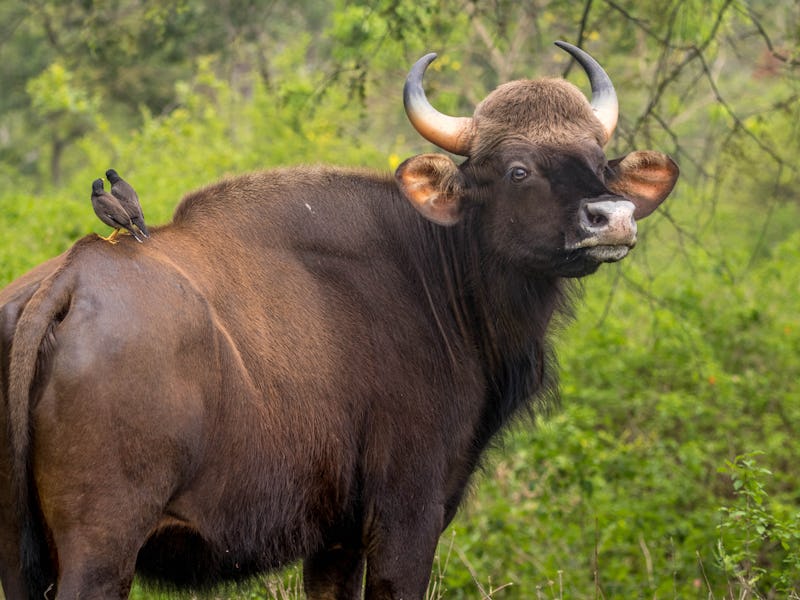Ancient cow DNA reveals critical transition moment for first human farmers
Now blanketed in snow, one of the iciest regions on Earth may once have been a tropical haven for ancient humans.

The Tibetan Plateau is famous for being both massive and freezing. Across this about 1 million square mile area, temperatures drop to as low as -40 degrees Fahrenheit in the winter.
These harsh, punishing conditions seem inhospitable today — but once, they were a crucible for a critical moment in ancient human society.
A new DNA analysis of a group of ancient animals called bovids (which includes cattle, bison) and rhinoceroses reveals this icy region may have once been temperate — even tropical. The findings suggest the ancestors of traditionally tropical species, including gaur and Sumatran rhinos, once called this plateau home and may have only migrated south in later years due to climate change.
The study was published Monday in the journal Proceedings of the National Academy of Sciences.
This new insight into the Tibetan Plateau's ancient environment gives scientists an unprecedented look at a crucial moment in human history: when ancient humans transitioned from being hunter-gatherers to farmers.
Sumatran rhino may be the direct descendants of ancient bovids that roamed the Tibetan Plateau some 5,000 years ago, the new study suggests.
Fresh analyses — The zooarchaeologists behind this study are not the first to ponder the origin of these ancient bovid fossils.
"Bovid remains have also been identified [in the area] and they were tentatively recognized as Tibetan yak or domestic cattle," explain the authors — rather different to the ancestors of tropical gaurs and rhinoceroses identified here. The gap may stem from the fact that many of the samples used in the old studies were too degraded to be analyzed using advanced morphological approaches.
So the researchers behind this study took a different approach — instead of looking at physical features, they looked directly at the remains' DNA.
Using a mix of whole-genome and mitochondrial DNA analysis on specimens dating back about 5,200 years, the researchers homed in on which modern bovid species the remains most closely matched on to.
"Up to now, there has been no record that gaurs once inhabited relatively high latitudes in northern China, especially in the higher-altitude [plateau,]" explain the authors. "[But] our systematic [ancient] DNA dissection revealed that the present-day low-latitude tropical rainforest gaurs and Sumatran-like rhinoceroses once rambled over northern Asia."
Modern-day gaurs (similar to bison) and Sumatran rhinos wouldn't last long on the frigid Tibetan plateau today, but the researchers use their analysis to reveal the plateau's ancient climate may have been much more to their liking.
By studying paleoclimate data from the period the remains date to, the researchers discovered that the environment would have actually been relatively warm and moist.
Bovid and rhinoceros bones found on the Tibetan Plateau and included in the study.
First farmers — This new information, combined with the number of wild bovid remains discovered, suggests ancient peoples living in this region may have first combined hunting with agriculture, as opposed to moving directly to domesticating animals in addition to farming.
Researchers believe the transition from hunter-gatherer lifestyles towards agricultural societies may have taken place as the climate warmed, and the wild gaur and Sumatran rhinos moved south for warmer temperatures.
These findings suggest that the Tibetan Plateau may have been one of the last habitats suitable for hunting in ancient East Asia, the authors say.
This new analysis will help researchers study the plateau's biodiversity, as well as how these bovids may have been instrumental in ancient peoples' initial exploration of the environment.
Further research will be needed to fully color in the picture of what ancient life might have looked like on the Tibetan Plateau, but the researchers behind this study say that these initial findings can help us begin to understand more about the complex relationship between these ancient humans and the environment they lived in.
"[T]he impact of the geographical distribution of wildlife on human behavior during that period remains enigmatic," write the authors. "This [work] highlights the intimate connection among climate change, the geographical distribution of wildlife, and human hunting behavior in northwest China during that period."
Abstract: Local wild bovids have been determined to be important prey on the northeastern Tibetan Plateau (NETP), where hunting game was a major subsistence strategy until the late Neolithic, when farming lifestyles dominated in the neighboring Loess Plateau. However, the species affiliation and population ecology of these prehistoric wild bovids in the prehistoric NETP remain unknown. Ancient DNA (aDNA) analysis is highly informative in decoding this puzzle. Here, we applied aDNA analysis to fragmented bovid and rhinoceros specimens dating ∼5,200 y B.P. from the Neolithic site of Shannashuzha located in the marginal area of the NETP. Utilizing both whole genomes and mitochondrial DNA, our results demonstrate that the range of the present-day tropical gaur (Bos gaurus) extended as far north as the margins of the NETP during the late Neolithic from ∼29°N to ∼34°N. Furthermore, comparative analysis with zooarchaeological and paleoclimatic evidence indicated that a high summer temperature in the late Neolithic might have facilitated the northward expansion of tropical animals (at least gaur and Sumatran-like rhinoceros) to the NETP. This enriched the diversity of wildlife, thus providing abundant hunting resources for humans and facilitating the exploration of the Tibetan Plateau as one of the last habitats for hunting game in East Asia.
A previous version of this article misidentified rhinoceroses as bovids. We regret the error.
This article was originally published on